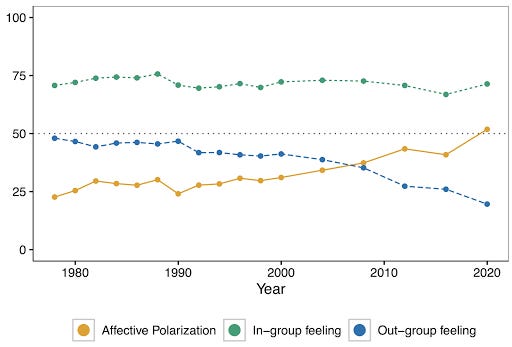Why we can't easily compare Joe Biden's approval ratings with past presidents' numbers
Polarization has introduced hard upper and lower bounds to a president's performance, making longer historical comparisons irrelevant without proper context
Today is Biden’s 99th day in office. Tomorrow, on his 100th, I expect we will see a torrent of news articles comparing his approval rating to past presidents’ numbers.
Most of these articles risk making a big mistake.
Because political polarization has increased so much since the 20th century, we can no longer expect a president to receive a traditionally “high” or “low” rating. This makes historical comparisons meaningless unless they have the proper context.
Take this chart, published in the Washington Post last week, as the first step on our journey. The chart shows both political parties’ rating of each president in every Gallup poll conducted since 1945. The pink bars show the rating of the president for his own party and the orange his rating for people belonging to the opposition. The grey bars are the president’s overall rating.
Notice how Gallup’s polls have shown increasingly large divides between the parties on their rating of presidents as time has gone on. In the 1940s, it was rare but not impossible that the party of the president would give the president an approval rating less than 20 percentage points higher than the party out of power. The chance of that happening declined thereafter, happening scarcely for Carter and HW Bush but no other president. Then, since the 1990s, a huge separation has emerged between the party in power and the out-party, with most of it happening after Obama was elected.
This chart published by The Economist shows a simpler way of looking at these differences, charting the president’s approval rating among Democrats, Republicans, Independents and overall for the first Gallup poll of each president since Eisenhower:
One thing to note is that Obama’s first polls were unusually high, and quickly fell back down to earth. So it’s also worth taking in this chart from FiveThirtyEight, which shows the partisan and overall ratings over the average of each president’s first 100 days, (which might help to cancel out some noise from the honeymoon period). Since 2010, the gap between each party’s ratings of the president has exploded:
….
The worsening partisan divide in ratings of the president matches rising levels of so-called “negative partisanship” in America, as this chart of American National Election Studies data from my friend Yphtach Lelkes, an Associate Professor of Communication and Political Science at the University of Pennsylvania, shows:
In the past, you were able to find Democrats and Republicans who rated members of the opposition party rather similarly. On average, the above graph shows, there was just a 25-point difference between the in- and out-party on a so-called “feeling thermometer,” where the pollster asks people to rate their and the other party on a scale from 0 to 100. But that gap has exploded since the 90s — to the point where the average difference is now higher than 50 points.
This makes it less likely that people who voted for the president will ever give him a bad rating, and more likely that those who voted against him never will.
But if the psychology of the American voter has changed, shouldn’t our coverage of their ratings of the president change too? Because people are less likely to change their ratings of the president to adapt to the job he is doing in office, the aggregate share of people who would approve or disapprove of him is stuck inside a narrower range of values. During Richard Nixon’s presidency, for example, the share of Republicans who approved of him fluctuated wildly between 40 and 80%; Democrats even gave him net-positive ratings sometimes.
Is it fair to compare the modern president’s with that baseline? I believe that it is not. If roughly 45% of the country is Republicans, as Gallup says, and their approval rating for Joe Biden will never slip below 80%, then Biden’s approval rating can never go higher than 64%. Add in the assumption that at least 30% of the 10% of people who identify as pure Independent will always disapprove of him, and his maximum approval rating is now 61%.
Maybe, all things considered, Gallup’s 57% rating is actually pretty good.
…
Over the next few days, you’ll probably see a lot of headlines comparing Biden’s approval ratings to the 60 and 70% approval ratings of the presidents that came before him. Some outlets may even spin this as a sign that he is a relatively unpopular president, or that he is lagging behind expectations.
This has more to do with the shape of our politics than the performance of the president.








Thank you. Excellent and insightful. All we need now is the means to turn off or at least mute the hyper-partisanship. Biden is appealing us to treat others with comity and move away from an “Us vs Them” view. Trump stoked fear and divisiveness.